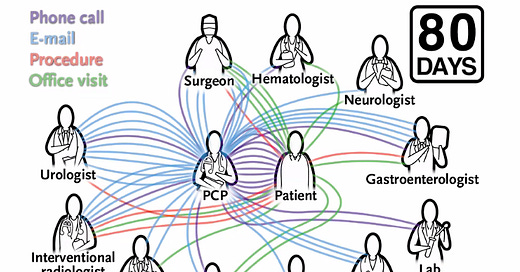FountainBlue's January 20 VIP Roundtable was on the topic of 'Data Meets Healthcare'. Our executives in attendance represented a wide range of backgrounds, experiences, roles, and organizations, but they each have extensive healthcare experience and most of them also worked in the technology space, bringing that knowledge and culture to the healthcare space. Below is a compilation of their thoughts on how data meets healthcare.
Source: New England Journal of Medicine, 2014
Our executives agreed that although it's important to bring data into healthcare, it's not always easy for many reasons: 1) there's so much data available from a wide range of sources, and the volume keeps growing, 2) there are so many groups with a wide range of needs, who need access to different slices of that data, 3) the various players across the ecosystem had historically created silos of information, processes and protocols which make it difficult for others to access, 4) there are regulations, guidelines, laws, requirements, protocols, policies and mandates which limit what can be done, and how things can be done and when, which makes it difficult for solutions to be developed quickly and efficiently, and 5) it's difficult to communicate and connect with the right people and resources so that we can all benefit from the data we get from healthcare sources.
With all these challenges in front of us, we were heartened to see how each participating executive and their organizations are addressing this opportunity and challenge. Below is a summary of best practices.
Do your part to facilitate the visibility of data and interoperability of data between the various players across the ecosystem so that all benefit.
Connect which would allow patients to navigate seamlessly to manage their care and drive outcomes for patients.
The healthcare industry needs leaders from the technology industry to help integrate solutions which leverage data to improve patient outcomes.
Use data to proactively manage administrative burdens and optimize workload, resources, and personnel with the intent of improving patient outcomes.
Gather data from patients even when they are not in the office using sensors and AI/ML solutions.
Create actionable, data-based dashboards which are relevant for the targeted audience.
Leverage the volumes of data to help clinicians and providers manage treatment offerings, working with representatives across the patient care ecosystem.
Consider what happens on the 'tile floors' of a hospital or clinic, but also what happens on the 'carpeted floors' for the provider.
Patient experience has historically not been a priority, but there are opportunities ahead where patient experience will become a huge factor in improving health and financial outcomes.
Real-time patient monitoring provides opportunities to proactively manage patient care.
The pandemic accelerated many changes in healthcare, but there is more work, and data will continue to play an important role for improving outcomes in a slow-moving industry. And leaders and organizations like the ones represented in this morning's program will continue to make inroads which benefit us all.





